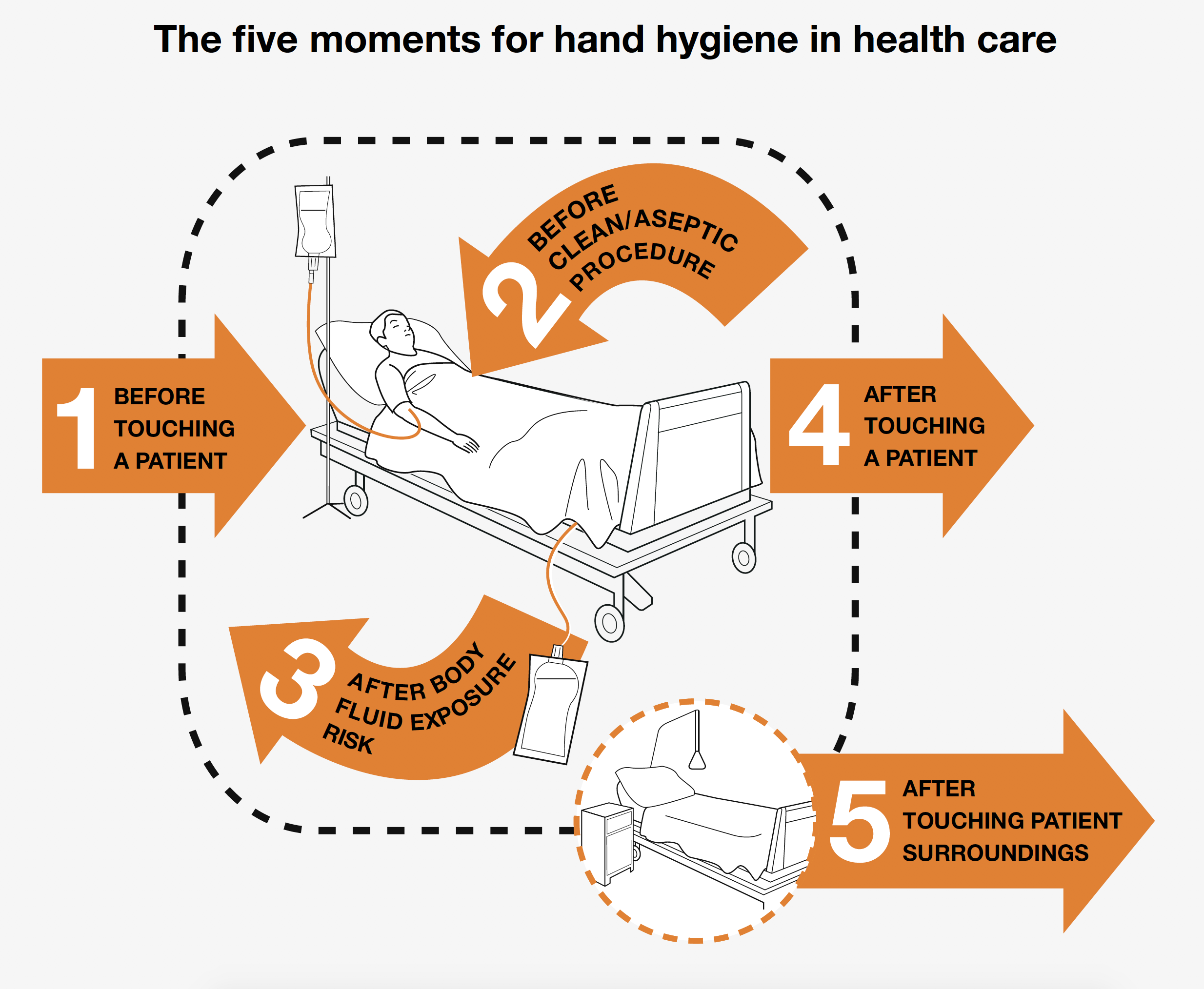Here are some of the most important things you can do stay healthy through good hygiene.
You might also like to rate your hygiene practices – take the quiz!
TOP HYGIENE TIPS
Wash your hands
“Wash your hands!” If you are a carer for young children you probably say this several times a day.
Closely followed by “Have you used soap?”.
Effective hand washing is one of the most important thing you can do to protect the health of yourself and others.
How should you wash your hands?
With soap and water
Wet your hands.
Add some soap and rub your hands together for 15-20 seconds, including your palms, the backs of the hands, fingers, nails, tips and webbing between fingers.
After lathering, rinse and dry your hands thoroughly (wet hands help transfer bacteria from surfaces that you touch to your hands).
When soap and water is not available
If you don’t have access to soap or water, wipes or alcohol-based hand rubs are effective options.
A wet wipe is the best option if your hands are visibly dirty. Wipe all over your hands until they appear clean (and remember to throw the used wipe in the bin!). Let your hands air-dry.
Alcohol-based hand rubs are not as effective if your hands are visibly dirty. Apply a small amount of product onto your hand and rub your hands together, including your palms, the backs of the hands, fingers, nails, tips and webbing between fingers, until hands are dry.
When should you wash your hands?
Before…
- contact with someone who is vulnerable to illness
- taking oral medicines
- handling contact lenses
Before & after…
- eating or handling food
- touching a wound
- inserting tampons or suppositories
After…
- coughing, sneezing & blowing your nose
- handling garbage or touching the bin
- touching animals
- changing a nappy
- using the toilet or bathroom
- handling money
- coughing, sneezing & blowing your nose
- anything else that makes your hands dirty!
TOP HYGIENE TIPS
Be hygienic when you cough and sneeze
If you cough or sneeze, catch it by covering your mouth and nose.
If you have a tissue, use it! Then bin your tissue and wash your hands straight away.
If not, cough or sneeze into your elbow.
Use a tissue if you have a runny nose.
Of course, good cough and sneeze hygiene is especially important if you are sick. You should also try to distance yourself from others, including by staying home from work or school when possible. Be particularly careful around vulnerable people – elderly, babies, pregnant women and the immunocompromised.
Avoiding close contact with people who are sick can also help decrease your chance of getting sick. If this is not possible, really ramp-up your hand washing frequency!
TOP HYGIENE TIPS
Be hygienic with food
What’s the first step? That’s right – wash your hands with soap before preparing food or eating.
Is it safe to eat?
Check the label for a use-by or best before date
‘Use-by’ dates are about health and safety. Don’t eat any food that has passed its use-by date.
‘Best before’ dates are about quality. Foods after this date may be safe to eat, but may have lost some of their sensory properties, e.g. flavour or texture.
Packaged food with a shelf life of 2 years or more does not have to have a date mark.
Use your common sense with foods that have longer shelf life. Throw away any obviously deteriorated food and cans that are bloated or highly dented.
Check food labels for particular storage directions.
Keep it hot, keep it cold, and never go back
The temperature danger zone for food is from 5 to 60 °C. You should try to limit the time that food spends in this temperature zone to no more than 2 hours.
Keep it hot…
- Cook foods thoroughly!
- Meat should reach 75 °C in the centre – use a meat thermometer to check, placing it in the thickest part but not touching bone, fat, or gristle. Eggs and egg dishes should reach 72 °C in the centre (or until the white is firm and the yolk thickens).
- Reheat leftovers to 75 °C, stirring to make sure the temperature is even.
- If you need to keep a plate of dinner warm, cover it and place it in the oven on the lowest setting.
Keep it cold…
- Your fridge should be between 0 and 5 °C.
- All perishable food should be stored in the fridge: raw meats on the bottom shelf and cooked foods on higher shelves, covered.
- Try not to over-fill your fridge – good air circulation between items helps keep them cold. If you are pressed for space, condiments, jams and bottled drinks could be removed for a period of time.
- Defrost foods in the fridge (or using the “defrost” microwave setting).
Never go back…
- Foods should never be reheated more than once.
- Defrosted foods should never be refrozen.
- Cooked food should be eaten immediately or covered, cooled and refrigerated or frozen within 1-2 hours of cooking.
- Throw away any food that has spent 4 hours in the temperature danger zone.
- Any uneaten “doggy bag” leftovers from restaurants or takeaway outlets should be discarded after 24 hours.
- Refrigerated leftovers should be eaten within 3-4 days.
Avoiding cross contamination
Cross contamination is when microorganisms from one area are transferred to another.
This can happen when you touch a contaminated site – e.g. the toilet flush, door handle, hand towel or kitchen sponge – and then touch food, a site that will come into contact with food, or somewhere on your body. Or, when you use a tea towel to wipe up a floor spill and then use it on the kitchen bench.
Wash your hands
At risk of sounding like a broken record – wash your hands.
Do this before preparing food. And after preparing food. And during handling food if you touch raw meat. Try not to contaminate the tap or any other surface with your meat hands.
It’s all about the hands.
Cleaning cloths
Different cloths should be used for different jobs. For example, a dishcloth used to wipe down a bench should not also be used to dry hands.
Use separate cloths for hand drying, dish drying, dishwashing and surface wiping. And if you quickly wipe up a spill on the floor with a handy dish cloth or tea towel, it should not be returned to surface or hand drying duties – into the wash it goes!
Take care with damp cleaning cloths and sponges as they can encourage the rapid growth of microorganisms. Rinse the cloth or sponge in cold water, wring out as much water as possible and lay it flat to dry.
Cloths should be washed or replaced regularly. Wash all your kitchen cloths on a hot cycle, separately to clothing loads. And don’t leave damp kitchen cloths in the laundry hamper!
Pest control
Keeping pests out of the kitchen will also help decrease contamination, as pests can introduce and spread microoganisms.
Keep food securely covered, remove food debris from floors and benches promptly, wipe down benches and stovetops at night and dispose of rubbish in a securely covered bin.
Without these temptations, pests are less likely to consider your kitchen a great place for a midnight feast.
Chopping boards
Use separate boards
Separate chopping boards should be used for different jobs. Most importantly, ready-to-eat foods should never be chopped on a board that has just been used to cut raw meat.
Once you have used a chopping board for raw meat, nothing else should be placed on it. Cooked meat? No. A sandwich? No. Tea towel? No. Your hands? No (wash them if you do).
Whilst it would be hygienic to use a chopping board for vegetables, remove them to a bowl, and then chop the meat on the same board (for example), having one board dedicated to raw meat avoids any confusion.
Having separate chopping boards helps establish a good hygiene habit and models hygienic food preparation to less-experienced cooks.
Clean your chopping board
How you should clean your chopping board depends on what it has been used for, and what it is made of.
For example, a chopping board that has come into contact with only vegetables and fruit does not need sanitising each time it is used, whereas a board that has been used for meat does.
You can sanitise your chopping board in the dishwasher if it is dishwasher-safe and you use a hot enough cycle. Wooden chopping boards cannot be treated in this way, and thin plastic may warp or melt. All chopping boards can also be cleaned and sanitised by scrubbing with hot water and detergent, then rinsing in hot water.
Please – don’t use a cloth to wipe down your chopping board and then reuse either the cloth or the board.
Make sure your chopping board is completely dry before putting it away. Standing the board in a drying rack will help.
Check the condition of your chopping boards regularly. If grooves develop on the surface, consider replacing the board as microorganisms can thrive in these hard-to-clean places.
TOP HYGIENE TIPS
Look after your teeth and gums
Good oral hygiene helps keep your teeth and gums healthy.
Regular brushing and flossing dislodges food caught in your teeth and helps remove plaque. Plaque is a film of bacteria that forms on the surfaces of your teeth and contributes to gum disease, tooth decay and cavities.
If it’s been a while between dentist trips (maybe it’s time for an appointment?), the following guidelines may help.
Brushing your teeth – when and how
Brush twice a day, in the morning before breakfast and last thing at night.
Brush for at least two minutes. The top, front and back of all teeth need to be brushed.
Dental Health Services Victoria recommends the following steps:
- use a pea-sized amount of fluoridated toothpaste (low-fluoride toothpastes are available for young children)
- use a soft toothbrush
- aim the toothbrush at a 45 degree angle towards the gum surfaces line
- use a gentle circular motion
- repeat on the inside surfaces
- use a light back-and-forth motion on the chewing surfaces
- spit out the toothpaste after brushing, and don’t rinse
The technique is pretty much the same whether you use a manual or electric toothbrush – but the electric toothbrush provides the circular motion for you.
Other tips for good oral health
- Drink fluoridated tap water.
- Cut back on sugar.
- Rinse your mouth after sugary or acidic food (e.g. beer, orange juice, soft drink, coffee).
- Cut back on smoking.
- Wear a mouthguard when playing sport.
- Model good oral hygiene practices to children.
- Use a mouthwash after brushing and flossing, which help get rid of any last bits of bacteria or leftover food that you might have missed.
Brushing your tongue
Brushing your tongue will also freshen your breath and clean your mouth by removing bacteria.
Some toothbrushes have a built-in scraper. If not, use the bristles.
Start at the back of your tongue and work forward. Drag the scraper or use circular motions with a brush.
When and how to floss
Floss once a day to help remove food and plaque from between the teeth.
The Australian Dental Association recommends the following steps:
- floss before you brush
- wind 30-40 cm of floss around your middle fingers and rest it across your thumbs and index fingers
- use a gentle up-and-down motion that goes down one side of the tooth, just under the little collar of gum and then back up the other side (think of it as an on-the-side “c”)
As well as flossing tape, interdental brushes, floss holders and disposable flossers may help you floss properly.
Avoid using toothpicks – they can make your gums bleed, which can lead to an infection.
Have braces or dentures?
If you have braces, follow the techniques for brushing and flossing recommended by your orthodontist.
To clean your dentures, remove them and use a denture brush with mild soap and water to clean all surfaces.
Store in a container of fresh, cold water overnight.
How to brush? [iii]
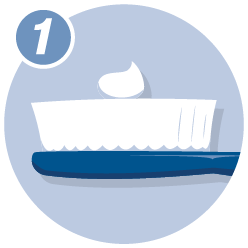
Use a pea-sized amount of toothpaste.
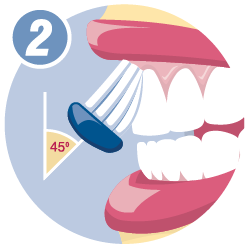
Aim the toothbrush at an angle towards the gum line.
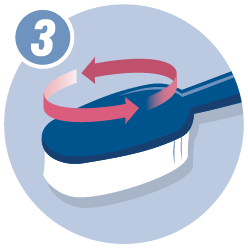
Use a gentle circular motion.
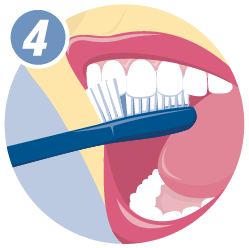
Repeat on the inside surfaces.
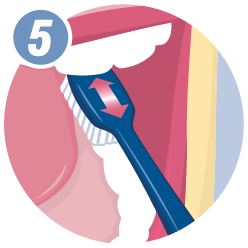
Use a light back and forth motion on the chewing surfaces.
TOP HYGIENE TIPS
Care for wounds
If you have a minor injury to the skin such as a cut or scrape, gently clean the area with cold water. Minor wounds are best left uncovered unless there is risk of cross-infection or of dirt getting into the wound. In these cases, a dressing should be applied to cover the area.
Depending on the injury, and if you are concerned about infection, you may also need to wash with a skin antiseptic or apply an antiseptic cream and cover the area.
TOP HYGIENE TIPS
Quiz: How good is your hygiene?
[i] Western Australia Department of Health, Facts about hand hygiene. Accessed 26/7/2019
[ii] Food Standards Australia New Zealand, 2013, Date Marking User Guide to Standard 1.2.5 – Date Marking of Food.
[iii] Dental Health Services Victoria, 2008, How to brush with dentures.

